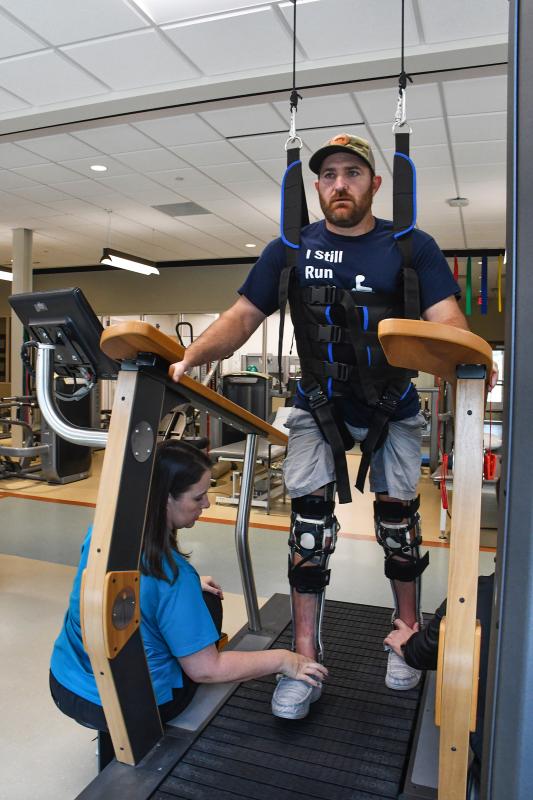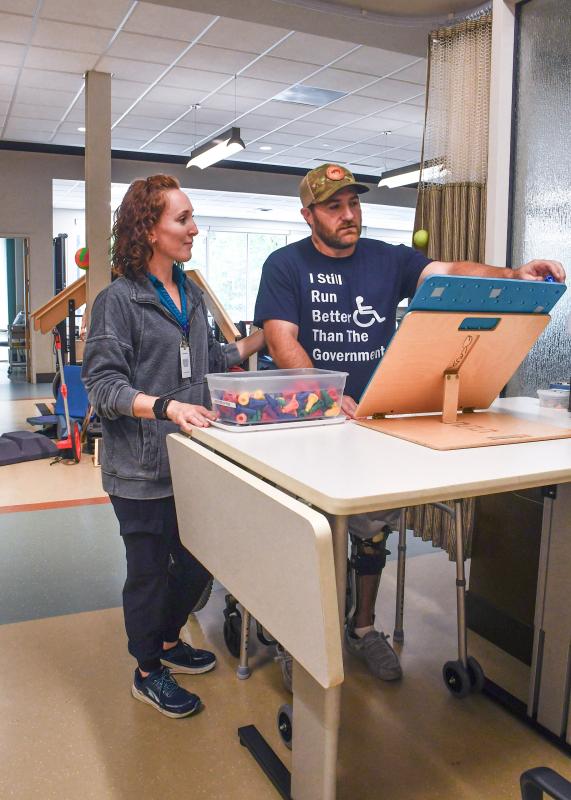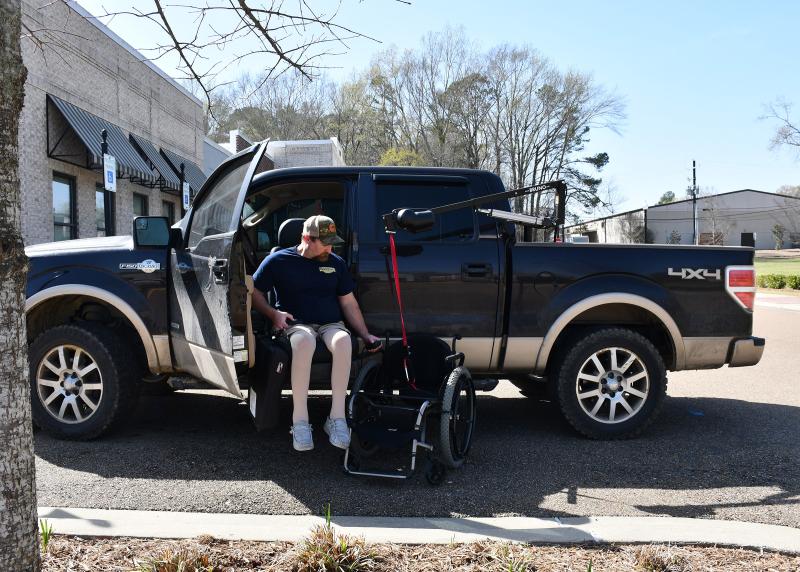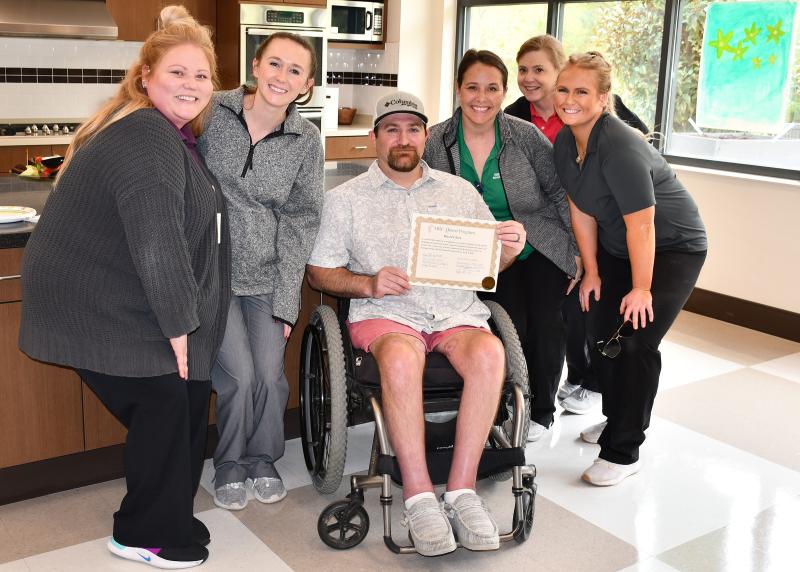David Clark hates laziness. He believes in working hard for what he earns. A resident of Grenada for more than 21 years, Clark built his business, Clark Construction, from nothing but honest work.
He’s taking the same approach for his latest project–a rebuild of his body following a spinal cord injury.
In a physical therapy session with Erin Perry, Clark urged Perry to let him walk further than his goal for the day. She reminded him, “Rome wasn’t built in a day.” Clark grumbled, “Yeah, but I’m sure they had it studded up and ready to go.”
Clark’s “get moving” attitude was one reason he and his wife, Tiffany, chose to complete his entire recovery journey with Methodist Rehabilitation Center.
“When I met the people at MRC, I realized they’re gonna push me to be the best I am gonna be,” he said.
Another reason the Clarks chose MRC was the type of injury Clark suffered on Dec. 23, 2021. While climbing a ladder to check on a roof–something he’d done more than a time or two–Clark had a seizure and fell over 30 feet. With a fractured T11 vertebra, Clark spent Christmas in the intensive care unit at The University of Mississippi Medical Center. His sons, Dawson and Tyler, refused to open their gifts until their dad got home.
Clark then spent two weeks recovering at Methodist Rehab’s inpatient rehabilitation center. As a man who loves the outdoors, he spent a good deal of time on the third floor deck instead of inside his room. In the therapy gym, Clark worked hard.
“The in-house physical and occupational therapy was great,” Clark said. “I wrote down all the names of my nurses because I just loved them.”
The Clarks decided care with MRC was worth the 100-mile drive from Grenada to Methodist Outpatient Therapy in Ridgeland. That distance paled in comparison to how far Clark wanted to progress physically.
He wanted to walk, so he would need leg braces and physical therapy. He wanted to drive, so he would need assistive devices and specialized occupational therapy. He also wanted to return to work, which made him a candidate for Methodist Outpatient Therapy’s Quest program. Quest is a program designed for patients desiring to return to school, work or specific community activities.
Occupational therapist Allison Harris knew Clark was only halfway through the mandatory six month break from driving that the state requires after a person suffers a seizure.
“I thought, ‘Okay, we have three months more where we can get him meeting some milestones functionally so that when it’s time to drive, he can even return to some work independently,’” said Harris.
Fortunately for Clark, his arms were strong before and even after the accident. Unfortunately for him, years of baseball wear and tear had left his shoulders in less than stellar condition.
“He was plenty strong,” said Harris. “But it’s one thing to be strong and another to transfer from a wheelchair. It’s a whole different thing to hold yourself up with only your arms.”
Despite his demanding therapy schedule and numerous doctor’s appointments, Clark still liked to tinker with his tools at home. Harris brought this into his occupational therapy, asking him to put together puzzles and do other activities while standing at a countertop.
Meanwhile, Certified Prosthetist and Orthotist Willie Spann created Clark’s braces. Predictably, they’re camouflage.
“I’m country, and that’s just the way it is,” said Clark.
Clark went shoe shopping after getting his braces. Because he refused to have help getting dressed, he chose HeyDude slip-on shoes with removable insoles and elastic laces. They were easier to put on and take off than rigid, traditional sneakers. It didn’t hurt that the brand is known for durability–Clark planned to cover some distance.
Physical therapist Erin Perry took every step alongside Clark. He started taking steps using a walker with a walker close behind in case he got tired. Eventually, Clark used a walker with upper body support and relied far less on Perry. He progressed to walking roughly 120 feet each physical therapy visit.
Clark also did sessions on the overhead, body-weight support treadmill. This particular treadmill also features a monitor, which allows the patient and therapist to watch for walking issues in real time. Because the patient is “unweighted,” walking much longer distances is possible and less exhausting.
“It felt like it was stimulating muscles I hadn’t used in a while,” said Clark. “And I don’t have one of those at home,” he joked about the specialized treadmill.
He may not have advanced therapy equipment at home, but Clark certainly has support in his hometown. After the accident, friends of the Clarks organized the First Annual David Clark Cornhole Classic. Proceeds from registration to the tournament and a long list of auction items were donated to Clark and his family to help with his expenses.
“When you have a friend in Grenada, you really have a friend who will do for you,” said his wife.
Making the drive from home to Ridgeland each week got much easier for Clark when the assistive devices for his truck arrived and were installed. Instead of relying on someone else to drive him, Clark hit the road on his own. For most patients, adapting to hand controls can be challenging, especially in a large vehicle. Clark had operated plenty of machinery, and as it turned out, those skills translated.
“I have used hand controls on trackhoes—levers to move forward and backward—so this wasn’t that hard of a transition,” he said.
Clark’s new rig features a Bruno Out-Rider Wheelchair Lift, which is specifically made for trucks. With the press of a button, Clark’s driver’s seat is brought to wheelchair level so that he can easily transfer into it. Then, the driver’s seat raises until he is positioned behind the wheel. The Out-Rider Lift, which clips to the wheelchair, places his folding wheelchair into the bed of his truck. In a matter of minutes, Clark is ready to go.
Harris, a Certified Driver Rehabilitation Specialist, spends much of her time analyzing specific activities and designing a safe way for her patients to do them. In Clark’s case, seat and wheelchair lifts spare his already overworked arms and shoulders.
“You can be just as successful with an adaptive strategy or device as you can a ‘muscle it through’ approach,” she said.
With the right strategies and Clark’s relentlessness, he’s cleared to visit job sites and bid on projects for his construction business. Because he’s not doing the work hands-on anymore, his next rebuild is his workforce. In the meantime, his tinkering with woodworking has developed into building birdhouses and charcuterie and cutting boards.
Although he met all of his therapy goals and can walk with his leg braces, Clark still hopes for opportunities to improve physically and walk without assistive devices.
“You gotta shoot for the stars,” he said.




